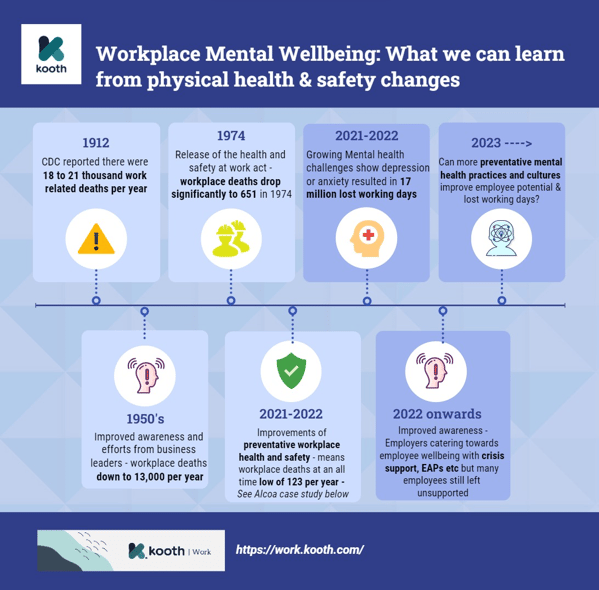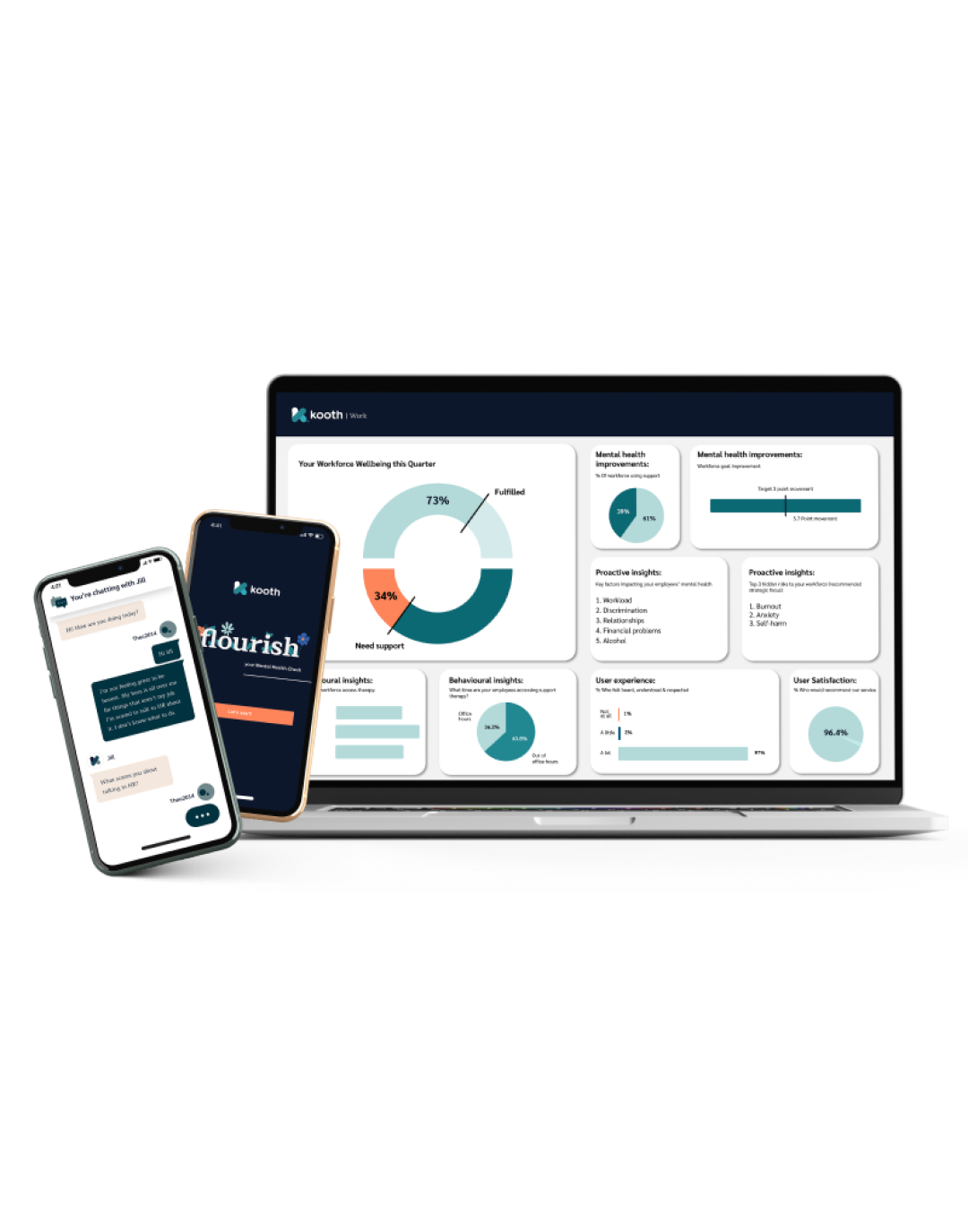How can employers and wellbeing leaders learn from physical health and safety to improve employee mental wellbeing?
Over the last 10 years, the spotlight has intensified on the impact of poor mental health, prompting individuals and employers to recognise the urgent need for action. However, our current culture and workplace practices primarily focus on a reactive approach to mental health care. This article explores the results and benefits seen from preventative care to physical health and safety, and how the same preventative approach should be prioritised to solve a growing mental health crisis.
The development of health and safety practices
In 1912, the CDC reported between 18,000 to 21,000 work-related deaths. At the time, workplace safety was regarded as the responsibility of the individual.
Since then, there has been increasing recognition of the impact workplace accidents and absences can have, prompting organisations to address the issues. Initially, industries predominantly relied on reactive approaches, responding to incidents once they had occurred. However, over time, there has been a notable shift towards preventive measures, with the past two decades showing the most marked progress.
This shift in approach has yielded significant benefits, as you can see from the graphic below, over slightly more than a century, workplace deaths have dropped from around 21,000 to 123 per year in the UK. The question being, can we learn from the effectiveness of preventative measures, apply it to mental health and accelerate the time in which the results are seen?
How one manufacturing company changed workplace safety culture forever
A perfect example of how prioritising a preventative health and safety approach has been beneficial is Paul O’Neill’s work at the aluminium manufacturing company, Alcoa, between 1987 and 2000.
At the start of Paul’s appointment in 1987, he identified that Alcoa workers were missing many days of work due to injuries, and he prioritised reaching a zero-injury milestone.
Initially, investors were perplexed at the apparent de-prioritisation of revenue targets, debt ratios, share prices, etc. Yet, by the time O’Neill retired in 2020, Alcoa was one of the safest working environments in the world; many Alcoa facilities went years without a lost working day due to injury, and work related injuries fell to one-twentieth of the national average.
The impact this had to employee and organisational potential was huge; the company’s annual net income rose to five times of what it was before he arrived, and their market capitalisation rose by $27 billion. You can read more about the Alcoa case study on Forbes.
Several case studies and analyses have shown that the key to this success was a shared focus on something important (a keystone habit). Prioritising a safe employee environment through preventative care to encourage reciprocal effort and potential from employees. In this instance, the focus was worker safety, but a company can get comparable results from focusing on innovation, employee engagement, or worker mental health and wellbeing.
From physical safety to psychological safety
Covid-19 put a greater spotlight on mental health, and we are seeing a very similar trend to that of workplace health and safety in the early 1900s. With 1 in 6 people facing a significant mental health problem such as depression or anxiety each week, poor mental health is now the number one cause of all lost working hours across the country.
Mental health is having lasting impacts on an individuals’ potential and their ability to work. While there’s been more focus on employee mental health support lately, it’s still at a reactive stage.
Why reactive and crisis stage support may not be enough
Many organisations we speak to provide EAPs, counselling, and other support options tailored toward individuals at a crisis stage, where they may require professional intervention and support. However, because this is focussed on the crisis end of the spectrum, engagement will typically be low, with around 5% of the workforce qualifying and using its support.
The challenges being faced by the other 95% of staff aren’t normally as visible or are not yet severe enough to require reactive support. Left unsupported, staff with lower levels of need can develop into higher levels of acuity stages, and even lower level needs can have a significant impact on the individual's ability to work and perform at their best.
A preventive approach for better worker mental health
There is a real opportunity to learn from the results seen through health and safety developments since the 1920s, to provide a workplace culture that addresses causes of poor mental health before they become a more serious issue. An article from Forbes, already reports the increased ROI of prevention and early intervention approaches, producing £5.60 for every £1 invested.
Companies can maximise preventative approaches by using risk assessments tailored and specialised toward mental health to validate and understand what support is needed and where (e.g. Flourish mental health benchmark). The aim here is to help shift the current approach to monitoring workplace wellbeing away from absences, leavers, and crisis support, which only measure when things have already gone too far, to include a wider, more proactive view of monitoring early indicators (e.g., stress/burnout/anxiety) and catch potential risks before they can take hold.
You can read more about the benefits of data insights and reporting for wellbeing leaders in this article.
Effective preventative measures can take many forms, but giving people a diverse range of options in an easily accessible and anonymous format appears to be the most effective. This also promotes usage by reaching the people that may not fall into the catchment requirement for the more crisis stage support, but whose mental health needs are at an early tipping point.
The ultimate aim of preventative support and strategies is to create a psychologically safe workplace and environment that can help mitigate the effects of poor mental health, whether it stems from work or personal stresses, and to help individuals reach their potential.
In summary
It’s clear that many positive steps have been taken towards workplace wellbeing, as organisations are recognising their important role in providing the best possible environment for their employees to flourish. However, we are at a key turning point, with opportunities to accelerate best practice through what we've already experienced.
Instead of responding to challenges when they surface, it’s more effective to prevent those challenges from occurring in the first place. It took over 100 years to truly see the benefits with relation to physical health and safety. Can we learn from lessons like that from O’Neill at Alcoa and apply the same successful strategies to tackle the growing mental health problem?
Our workplaces can all become safe and restorative environments with the capability to support individuals in overcoming challenging mental health problems. The rewards of preventative mental health support could be huge, for both individuals and organisations. Investing fully in your employees can lead to a surprising return on investment, as when employees feel truly valued, prioritised, and cared for, they’re likely to do their best work.
For more about employee mental wellbeing, check out our articles:
An employers guide to creating a mentally healthy workplace
Next level leadership for managing change
Understanding and supporting the mental health needs of key worker frontline staff webinar
How far should HR teams go to prioritise employee mental health?







